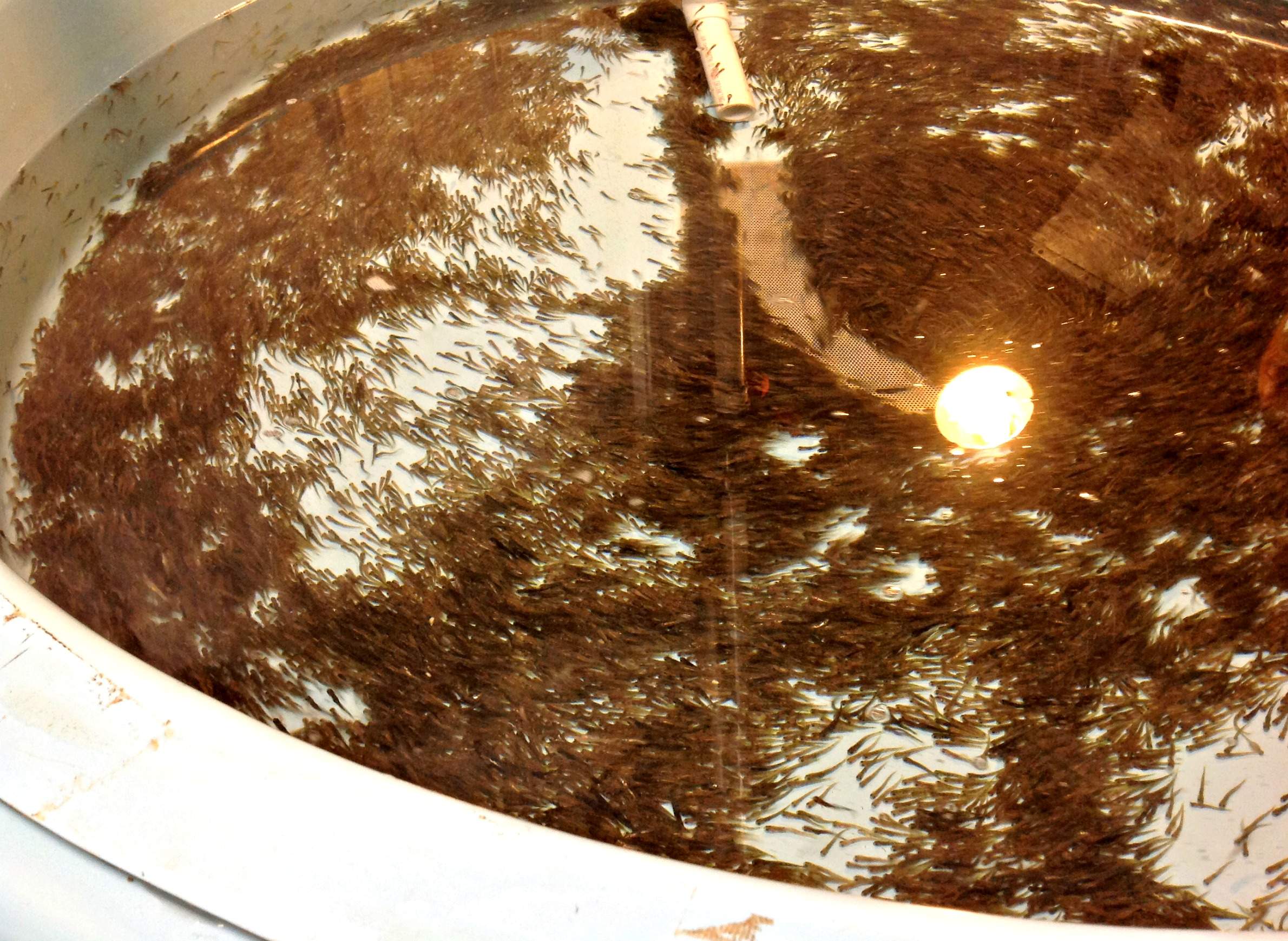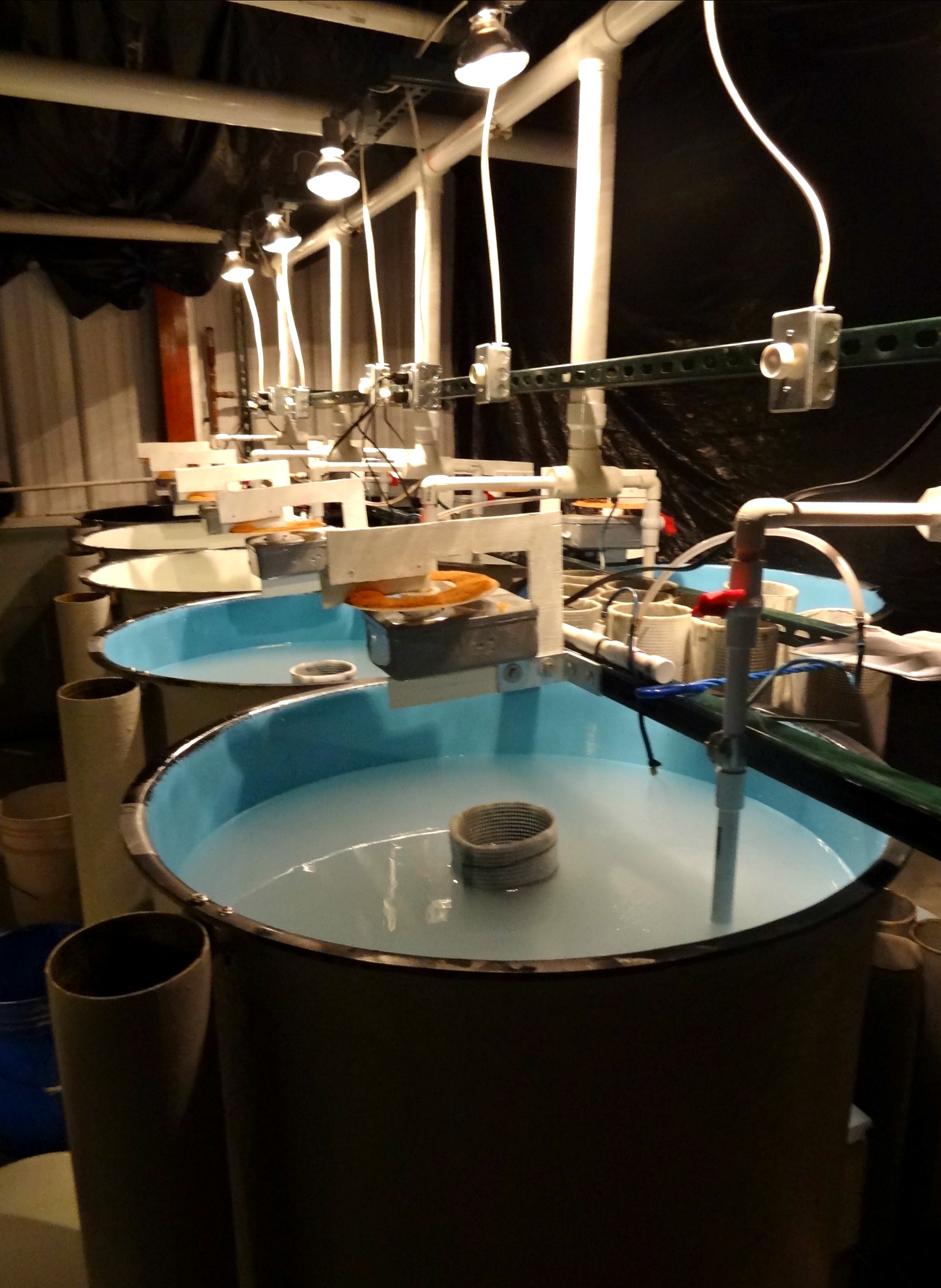
Economic Opportunity, Fragile Fisheries Drive Aquaculture In Wisconsin
Around the world, an increasing proportion of the fish and other seafood people eat, catch, use as bait or put in aquariums is raised in controlled environments in a practice known as aquaculture. This industry is growing quickly in Wisconsin, with fish-based operations ranging from small family ponds to large-scale farms like Rushing Waters in Palmyra. A few aquaculture businesses in the state are even experimenting with raising shrimp.
Researchers are applying the Wisconsin Idea to this approach to growing food, especially at the Northern Aquaculture Demonstration Facility, a project of the University of Wisconsin-Stevens Point and partner of the UW Sea Grant Institute. Opened in 2003 in Red Cliff near the shore of Lake Superior, the facility's goal is to promote the development of aquaculture in more northerly climes. NADF focuses on developing sustainable aquaculture systems that recirculate water to minimize environmental impact. Species raised at the facility include yellow perch, coho salmon, and various kinds of walleye. It hosts different indoor and outdoor aquaculture systems, and collaborates with tribal, state, federal, academic and private partners to conduct research and training.
UW-Stevens Point has also partnered with Montello-based aquaponics company Nelson and Pade to develop the first university aquaponics course in Wisconsin.
NADF manager Greg Fischer offered some perspective on the state of aquaculture in Wisconsin and around the world in a July 30, 2015, lecture at the Northern Great Lakes Visitor Center in Ashland. His talk was part of the Northern Lights Tour presented by the Wednesday Nite @ the Lab lecture series and was recorded for Wisconsin Public Television's University Place. Fischer gave an overview of how aquaculture is growing in prominence as commercial fishing in the wild threatens the stability of fish and other animal populations. He also detailed how NADF promotes the growth of aquaculture in Wisconsin through its partnerships with businesses, academics, and government agencies. Fischer argued that farm-raised seafood, managed properly, tastes better than wild-caught options, and noted aquaculture reinforces efforts like Monterey Bay Aquarium's Seafood Watch that encourage people to think about where the food on their plates comes from.
Key facts
- Over time, more "capture" (commercial, open-water ) fisheries are becoming over-exploited or have crashed, while more tainted and mislabeled seafood is entering the market and ending up on consumers' plates. These challenges mean aquaculture is becoming a more crucial source of seafood to feed the growing global population’s demand for protein.
- Aquaculture is the fastest-growing method of food production in the world, and about half of the seafood eaten worldwide is raised through aquaculture.
- More than 90 percent of the seafood Americans eat is imported from other countries, but U.S. regulators can't regulate fish farms in other nations.
- Wisconsin has the most aquaculture activity of any state in the Midwest.
- In Wisconsin, most live fish bait used for recreational fishing is raised through aquaculture.
- Aquaculture does have an environmental impact, especially through waste generated by the animals being raised.
- "Net-pen" aquaculture, which uses a cage or pen placed within a lake or ocean to raise animals for harvest, is not practiced in Wisconsin. It's one of the more environmentally damaging methods of aquaculture, because it allows waste, disease and possibly escaped fish to flow freely into wild habitat. Other aquaculture methods are closed systems kept separate from natural bodies of water, or contained within seasonal ponds.
- Another closed and usually indoor method of aquaculture is called aquaponics, which combines the raising of fish and plants. Aquaponics systems use fish waste to fertilize the plants and plants to purify the water in which the fish live, with the intention of harvesting both.
- In Wisconsin, there were more than 2,500 registered fish farms as of July 2015.
- Aquaculture production is expected to rise 33 percent from 2015 to 2025. Some observers have predicted that by 2018, it will exceed commercial open-water fishing around the world.
Key quotes
- On the growing importance of aquaculture as the world's population (and food demand) grows: "Fish is really becoming a sought-after resource, and the capture fisheries just can't keep up with that."
- On cheap but mislabeled imported fish and their impact on WIsconsin's Friday fish-fry: "If you can get walleye for $7.99 all-you-can-eat, it's not walleye. It's probably something from Europe, like a zander, or a European walleye, and it doesn't taste the same as our walleye, and it's not farmed the same, and it's not captured the same — [it] doesn't have the same attributes that our walleye would have."
- On impact of aquaculture on live-bait users: "You used to be able to get a dozen minnows for about a buck. How much are a dozen minnows now? They're about 7 or 8 dollars for a dozen minnows. It's because of that [regulation] and the process involved in rearing."
- On the environmental perceptions of aquaculture: "A lot of these horror stories we hear about are related to net pen culture, usually on the East Coast or maybe the West Coast, and we're pretty far away from that here in the Midwest, so we don't hear everything, we just hear little bits and pieces on the news, like 'net pen falls apart due to heavy waves,' and fish are released all over and officials are upset ... but one of the cool things is, there is no net-pen fish farming in Wisconsin. We don't have it. I don't see it coming to Wisconsin anytime soon."
- On the history of farming fish and plants together: "It goes all the way back to early Egypt and the Chinese, but recently we've seen a resurgence in aquaponics."



